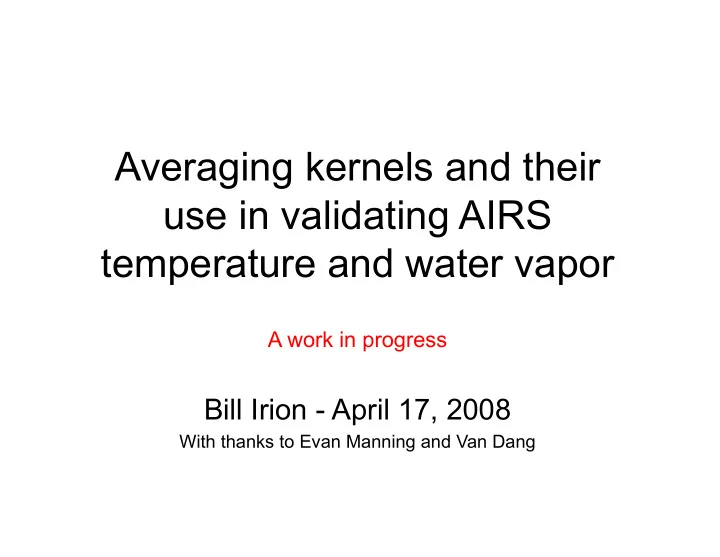

Averaging kernels and their use in validating AIRS temperature and water vapor A work in progress Bill Irion - April 17, 2008 With thanks to Evan Manning and Van Dang
What’s an averaging kernel? The averaging kernel matrix is a measure of how and where the retrieval is sensitive to changes in the “true” state. Retrieved state vector A = ∂ ˆ x ∂ x “True” state vector For AIRS averaging kernel derivation and discussion, see Maddy and Barnet, Vertical resolution estimates in Version 5 of AIRS operational retrievals, submitted to IEEE Trans. Geosci. Remote Sensing , 2007
Sample temperature averaging kernels 2005.07.12 Alajuela, Costa Rica dˆ dˆ x /dx x /dx • AK is affected by signal-to-noise and local conditions (e.g. temperature gradient) • The depth (x-axis) of a curve is indicative of sensitivity • The width (y-axis) is indicative of vertical resolution • The trace of the AK is the number of degrees of freedom
Sample water vapor averaging kernels Alajuela, Costa Rica 2005.07.12 2005.07.09 dˆ x /dx dˆ x /dx • Again, AK is affected by signal-to-noise and local conditions • Sensitivity decreases in upper troposphere and is absent in stratosphere
Using Averaging Kernels with correlative “truth” data • Every retrieval uses a combination of observed data and an a priori x est = x 0 + A ( x T − x 0 ) ′ • If sensitivity were perfect, A = I ′ • If were replaced by “truth” (say, a x T radiosonde profile), then would be a x est measure of what the instrument should have returned given its sensitivity. • Regression adds information that is not quantified
Procedure • Radiosonde data from Tobin, Voemel, McMillan, ARM SGP and NSA etc. (more work in progress) • Additional temperature data from WOUDC (great stuff!) • Slab columns calculated for water on AIRS 100-level grid • AIRS retrievals used to fill in “truth” above range of sondes • Sonde data must at least reach tropopause • Temperature quality flags = 0 for temperature comparisons, water quality flag = 0 for water • 1 hr, 50 km matchup range for temperature and water • “Kerning” calculation on sonde data uses ln(slab column) for water: ln x est = ln x 0 + A (ln x T − ln x 0 ) ′
Some average temperature comparisons Verticality (sum of row Of Avg. Kernel)
More average temperature comparisons
WOUDC locations
Tropical results (WOUDC sondes)
Polar Results (WOUDC sondes)
Water vapor comparisons (AIRS – sonde) / sonde (%)
Conclusions • Results often indicate improvement over a priori for temperature and water, but retrieval can often not recover from poor first guess. • More work needed on collating and quality–checking radiosondes • Work on mapping vertical resolutions
Recommend
More recommend